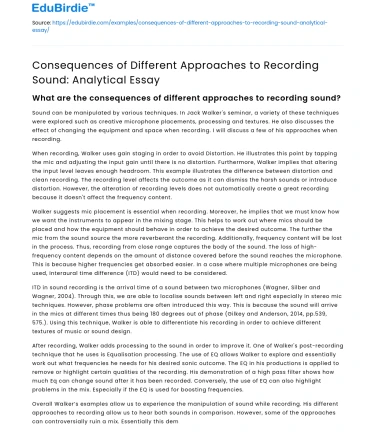What are the consequences of different approaches to recording sound?
Sound can be manipulated by various techniques. In Jack Walker's seminar, a variety of these techniques were explored such as creative microphone placements, processing and textures. He also discusses the effect of changing the equipment and space when recording. I will discuss a few of his approaches when recording.
When recording, Walker uses gain staging in order to avoid Distortion. He illustrates this point by tapping the mic and adjusting the input gain until there is no distortion. Furthermore, Walker implies that altering the input level leaves enough headroom. This example illustrates the difference between distortion and clean recording. The recording level affects the outcome as it can dismiss the harsh sounds or introduce distortion. However, the alteration of recording levels does not automatically create a great recording because it doesn't affect the frequency content.
Save your time!
We can take care of your essay
- Proper editing and formatting
- Free revision, title page, and bibliography
- Flexible prices and money-back guarantee
Walker suggests mic placement is essential when recording. Moreover, he implies that we must know how we want the instruments to appear in the mixing stage. This helps to work out where mics should be placed and how the equipment should behave in order to achieve the desired outcome. The further the mic from the sound source the more reverberant the recording. Additionally, frequency content will be lost in the process. Thus, recording from close range captures the body of the sound. The loss of high-frequency content depends on the amount of distance covered before the sound reaches the microphone. This is because higher frequencies get absorbed easier. In a case where multiple microphones are being used, Interaural time difference (ITD) would need to be considered.
ITD in sound recording is the arrival time of a sound between two microphones (Wagner, Silber and Wagner, 2004). Through this, we are able to localise sounds between left and right especially in stereo mic techniques. However, phase problems are often introduced this way. This is because the sound will arrive in the mics at different times thus being 180 degrees out of phase (Gilkey and Anderson, 2014, pp.539, 575.). Using this technique, Walker is able to differentiate his recording in order to achieve different textures of music or sound design.
After recording, Walker adds processing to the sound in order to improve it. One of Walker's post-recording technique that he uses is Equalisation processing. The use of EQ allows Walker to explore and essentially work out what frequencies he needs for his desired sonic outcome. The EQ in his productions is applied to remove or highlight certain qualities of the recording. His demonstration of a high pass filter shows how much Eq can change sound after it has been recorded. Conversely, the use of EQ can also highlight problems in the mix. Especially if the EQ is used for boosting frequencies.
Overall Walker’s examples allow us to experience the manipulation of sound while recording. His different approaches to recording allow us to hear both sounds in comparison. However, some of the approaches can controversially ruin a mix. Essentially this demonstrates that recording sound with a sonic goal can create a focused sound recording.
References
- Gilkey, R. and Anderson, T. (2014). Binaural and spatial hearing in real and virtual environments. New York: Psychology Press, pp.539, 575.
- Wagner, H., Silber, K. and Wagner, H. (2004). BIOS Instant Notes in Physiological Psychology. Abingdon: Taylor & Francis [Imprint], pp.98,99,100.
- Suzanne Parry – Community-Based Projects






 Stuck on your essay?
Stuck on your essay?

